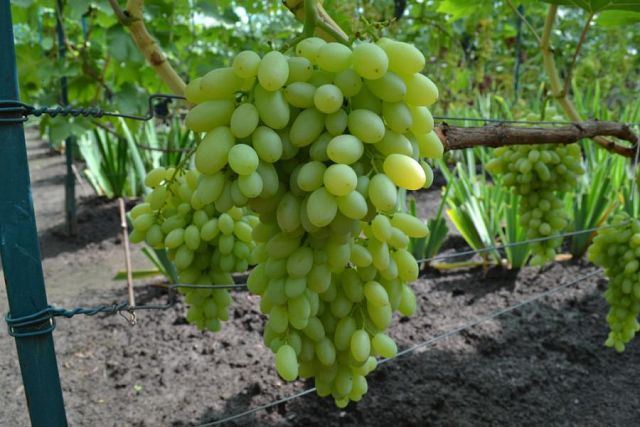The grape variety kummish for a century, despite such a short period of distribution in our country, has already managed to win love and popularity among many summer residents. This variety is used to make the highest quality raisins. Further we will talk about its description and we will consider the main characteristics
Table of contents
Characteristic and description of grapes century
The centenary was bred in the USA, California by a group of American breeders in the 1980s. This is the result of crossing varieties Gold and Q25-6.Experiments on breeding varieties lasted for 14 years. This species got to Russia only in 2010 and immediately became extremely popular.
Refers to early ripe varieties, the term of ripening berries is 120 days. Berries do not contain seeds. The weight of each brush is from 700 to 2000 grams. Experienced winegrowers recommend timely harvesting, so that the clusters do not crumble. The shape of the berries is oval-oblong, the color when ripe is golden yellow.
The mass of each berry is from 5 to 10 grams. The fruit has a nutmeg taste and a touch of tea rose. Taste may vary depending on the soil on which this variety grows. The skin is thin, has no taste, so the fruit can be eaten with the skin.
Fruit pulp dense, juicy taste sweet. Frost-resistant. Freely tolerated lowering the temperature to -25 degrees. The period of fruiting from mid-September until the onset of cold weather. Ripened brushes are advised to leave on the bush before the onset of frost, with the onset of frost, the berry gains the maximum amount of sugar.
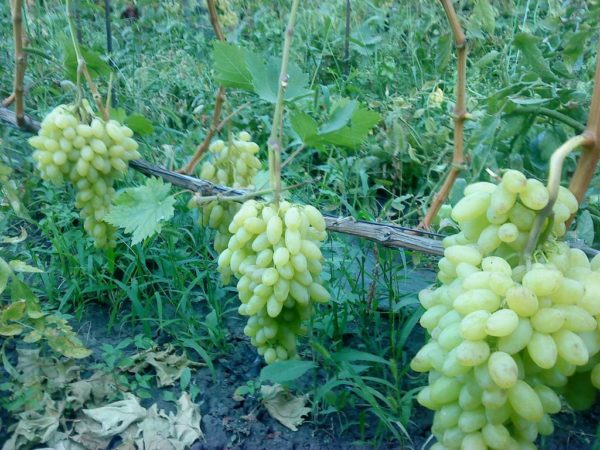
The merits of the variety
The advantages are:
- excellent taste;
- lack of seeds;
- good disease resistance;
- early ripening;
- not prone to decay and shattering;
- excellent presentation;
- frost-resistant;
- stability of high yields;
- berries are not prone to cracking.
The disadvantages include:
- no storage time;
- The need for thinning brushes.
Choosing a place for landing
Despite the fact that the variety is frost-resistant, the most favorable place for growth is the southern part of the site. Well, if the bushes will be planted next to the house or near the fence. The buildings will protect from a harsh wind and give additional heat.

The site should be well illuminated by sunlight from all sides. The soil for planting needs to be prepared in advance, so that she has time to settle down well and be fed with moisture and beneficial substances. The soil should pass moisture and air well. You can plant grapes in autumn and spring.
Selection of seedlings
The choice of seedlings must be approached seriously, since it depends on what the vine will be and, accordingly, its yield. Saplings can be classified as:
- elite;
- 1st grade;
- 2 grade;
- non-standard
Elite seedlings have four or more roots with a uniform arrangement, not less than 2 mm thick and from 25 cm long. The thickness of the base must be at least 5 mm.
Saplings of the first grade must have four or more roots. The difference from the elite is that the root thickness of 2 mm must be at least 2 roots. The distance of the roots from each other should also be uniform.
2 grade must have at least two developed roots.
Unqualified sapling has a weak, undemanding growth. It is better not to plant these seedlings.
Landing features
If the planting is planned to be carried out in the spring, then the soil for planting is prepared in the fall.. The depth of planting seedlings depends on the type of soil. In light soil, it is necessary to dig a hole with a diameter of 40 cm and a depth of 60 cm. In heavier soils, the area of the hole will be 70x80 cm, depth 70 cm. Favorably on planting, the presence of groundwater will be reflected. However, the plot under the vineyard should not be flooded with melt water. The soil should be sufficiently wet, loose, without weeds.
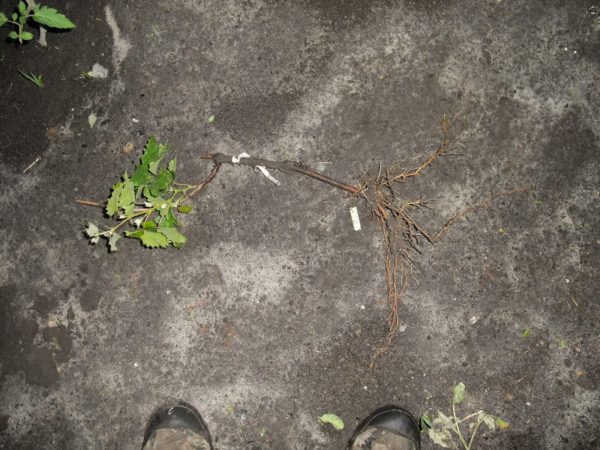
Before planting, the roots of seedlings must be treated with a growth stimulator. Purchased cuttings are soaked in this solution for a day, then disinfected with a solution of manganese, and after that they perform pruning of roots.
At the bottom of the hole you need to make a drainage layer with the addition of complex fertilizer. The seedling is planted in the hole and covered with soil, carefully tamped. In the absence of suitable soil for the grapes, the hole is filled with soil with the addition of humus. The distance between the seedlings should be at least 3 meters, as the vine has a rapid growth. Between the rows should be at least 2 meters with a single-lane landing and 3 meters with a two-lane.
Autumn planting is best done from the last days of October to mid-November. It is necessary to plant the grapes in a well-moistened land.
Care rules
After planting the grapes should pay special attention to the condition of the soil. The soil should always be loose and without weeds. On the tubercles loosening should be carried out carefully so as not to damage the young shoots. As the seedlings grow, the height of the tubercle is gradually reduced. In August, the seedlings open up to the place of spikes of grafted shoots.
At the end of June, it is necessary to perform the procedure for removing roots growing on the surface. This is done so that the bush develops roots deep into it, as the roots growing close to the surface reduce frost resistance and endurance during the drought period. It is necessary to perform pruning on a cloudy day. To do this, rake the ground around the seedling and make a hole 25 cm deep. To remove the roots, use a secateur. After trimming the hole fall asleep, leaving only the green mass of the bush on the surface.
For grapes grown from cuttings is very important for rooting watering. After planting, it is necessary to immediately water the seedling. The second watering is carried out in two weeks. The third watering must be done 35 days after planting. Depending on the dryness of the soil water consumption for each bush one or two buckets. For irrigation, it is best to use water heated in the sun. Watering exercise in the evening.
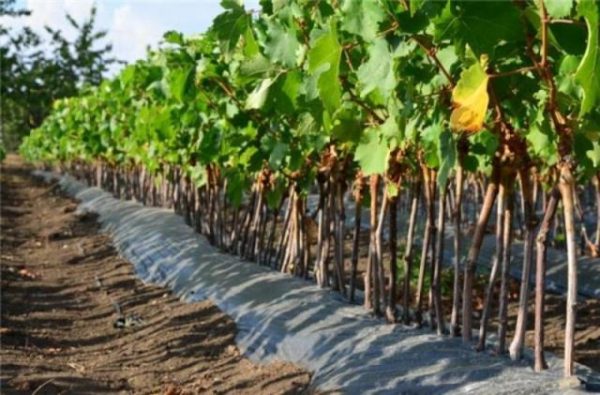
Feeding grapes carried out in the summer, combining them with watering. For feeding you can use fermented mullein.For digestion, mullein is diluted with water in a ratio of 1: 2 and left at a temperature of +22 degrees for two weeks. Then the finished slush is diluted with water 1: 4. Add to this solution:
- superphosphate — 100 grams;
- ammonium sulfate —75 grams;
- saltpeter —45 grams.
To prevent damage to shoots, they are tied up to stakes in an upright position. With abundant growth of stepsons, you must perform pinching. This procedure will accelerate the formation of bushes.
For the prevention of disease, young seedlings are sprayed with Bordeaux mixture.
In early October, the land in the vineyard is dug up, and in late October, when the foliage falls, the seedlings are sheltered for the winter. To do this, dig a groove, put it in the length of the vine and covered with earth.
In spring, young grape saplings are discovered later than an adult vine, since young shoots are more susceptible to frost. In subsequent years, the growth of caring for the vine is as follows:
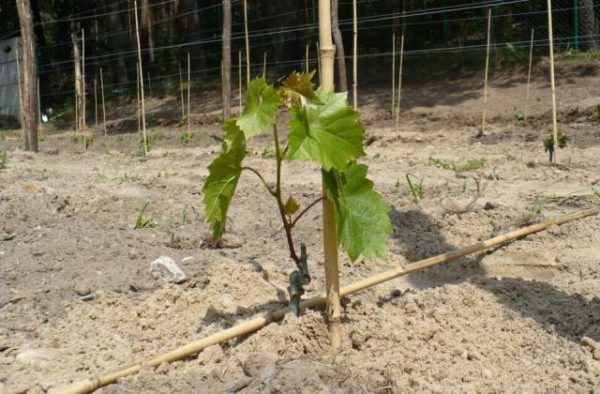
- trimming;
- pasynkovanie;
- loosening the soil;
- weed removal;
- fertilizer;
- watering;
- disease prevention;
- pest control.
Diseases and pests
This grape is almost not subject to diseases. However, it suffers from pest attacks of phylloxera. This pest damages the root system, plant whiskers and foliage. And in this case, no loss of bushes is complete. In the place affected by phylloxera, it is possible to plant grape bushes no earlier than after 5 years.
For the purpose of prophylaxis, they put a cardboard tube with a diameter of 15 cm on the roots of a sapling during planting. The tube is covered with sand and the seedling is dropped on the ground. The tube is then carefully removed.
If throughout the season, proper care activities were carried out, and the vine was properly prepared for wintering, then in the next season you can count on a good harvest.
